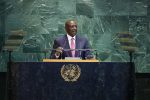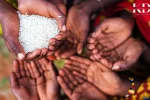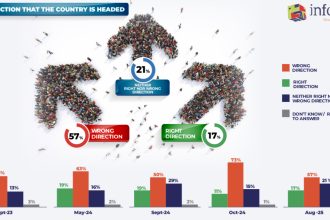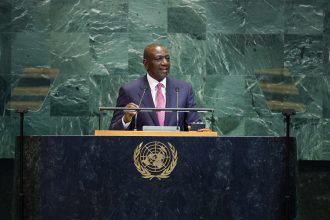On Monday, President William Ruto left for China on a State Visit marking another significant step to ramping relations with the East as the disruption brought about by US President Donald Trump continues to sink in.
This trip by Ruto comes at a time when China and the US are involved in escalating tariff wars and just weeks after a delegation led by Treasury Cabinet Sectary John Mbadi visited the Asian nation.
State House Spokesman Hussein Mohammed said that the visit by President Ruto marks a significant step in strengthening the already robust Kenya-China partnership.
This visit, rooted in the Comprehensive Strategic Partnership established in 2017, aims to unlock new opportunities in trade, investment, infrastructure, and regional cooperation, reflecting Kenya’s pivotal role in China’s Belt and Road Initiative (BRI) in Africa.
Kenya has been a cornerstone of the BRI in Africa, with flagship projects like the Standard Gauge Railway (SGR) and the Nairobi Expressway transforming its economic landscape.
The SGR, a $3.6 billion project funded largely by China’s Exim Bank, has eased transport between Mombasa and Nairobi, reducing travel time and boosting trade efficiency.
Similarly, the Nairobi Expressway, a $600 million toll road, has alleviated traffic congestion in the capital, showcasing the tangible benefits of Kenya-China collaboration.
These projects underscore Kenya’s role as a gateway for Chinese investment in East Africa, with bilateral trade between the two nations reaching $8.5 billion in 2023, according to the Kenya National Bureau of Statistics.
By visiting China, Ruto is building on this foundation, with a clear focus on advancing shared priorities in economic transformation, sustainable development, and global cooperation.
His bilateral talks with President Xi Jinping in Beijing are expected to yield agreements that further deepen economic ties, particularly in digital innovation and industrial development.
The inclusion of over 100 companies from both nations in the Kenya-China Business Forum during the visit highlights the private sector’s role in driving this partnership forward.
Boosting Agricultural Exports and Market Access
A key highlight of the visit is the inauguration of the Kenya Tea Holding Centre in Fujian Province, one of China’s major tea regions. This initiative aims to enhance the visibility and market access of Kenyan tea, a critical export that accounts for nearly 20 per cent of Kenya’s foreign exchange earnings.
In 2023, Kenya exported over 480,000 metric tons of tea globally, but its market share in China remains underutilised due to competition from other tea-producing nations like India and Sri Lanka.
The Tea Holding Centre is poised to support smallholder farmers by providing a direct channel to Chinese consumers, potentially increasing export volumes and improving livelihoods for millions of Kenyan farmers.
This move aligns with China’s broader strategy of importing more agricultural products from Africa, as seen in initiatives like the China-Africa Economic and Trade Expo.
The visit also emphasises Kenya’s ambition to become a robust industrial and logistics hub for East Africa through high-quality BRI cooperation. Kenya’s strategic location, with the Port of Mombasa serving as a gateway to landlocked countries like Uganda and South Sudan, makes it an ideal candidate for such a role.
The focus on building industrial capacity aligns with Kenya’s Vision 2030, which prioritises manufacturing as a driver of economic growth. By leveraging Chinese investment and expertise, Kenya aims to expand its manufacturing base, particularly in sectors like textiles and electronics, which could create jobs and reduce reliance on imports.
President Ruto will make a keynote address at Peking University which will highlight Africa’s vision for inclusive growth, leadership, and deeper South-South cooperation.
This platform provides an opportunity to articulate Kenya’s perspective on global challenges, including climate change and economic inequality, while advocating for stronger ties between African and Asian nations.
Additionally, discussions on peace and security in the Greater Horn of Africa and the Great Lakes Region signal Kenya’s intent to play a larger role in regional stability, with China’s support.
The Horn of Africa, plagued by conflicts in countries like Somalia and Ethiopia, stands to benefit from enhanced multilateral cooperation, particularly in areas like infrastructure development and counterterrorism.
Challenges and Criticisms
While the Kenya-China partnership has delivered significant benefits, it has not been without challenges. Critics often point to the debt burden associated with Chinese loans, with Kenya owing China approximately $6 billion as of 2024, according to the National Treasury.
The SGR, for instance, has struggled to generate sufficient revenue to service its debt, raising concerns about long-term sustainability.
Additionally, some Kenyan stakeholders have expressed unease over the trade imbalance—China exports far more to Kenya than it imports, leading to calls for more equitable economic relations.
Ruto’s visit may address these concerns by negotiating better terms for Kenyan exports and ensuring that new agreements prioritise mutual benefit.
President Ruto’s state visit to China marks a pivotal moment in Kenya’s foreign policy and economic strategy. By deepening ties with China, Kenya is positioning itself as a leader in African development while navigating the complexities of global geopolitics.
The outcomes of this visit—whether in trade agreements, infrastructure deals, or regional cooperation—will likely shape Kenya’s trajectory for years to come, offering both opportunities and challenges in equal measure.
As the partnership evolves, the focus on sustainable development, digital innovation, and inclusive growth could set a model for other African nations engaging with China.












